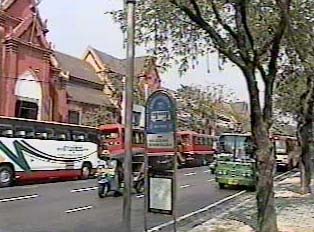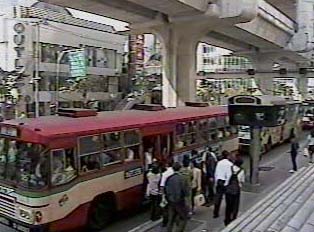LangMedia
Thai in Thailand
Local Buses

Local transportation buses are of two types: those with air-conditioning and those without. To tell the air-conditioning status of a bus, look to see whether or not the windows are open. Since buses of both types are many different colors, the window method is the most reliable. Buses without air-conditioning are cheapest, and the fare remains the same regardless of how far the passenger is traveling on the bus. Air-conditioned buses are more expensive, and the fares vary by destination.
A sign on the front of a bus gives its route number and final destination. Signs on the side of buses give the intermediate stopping points for the bus. Main bus stops have diagrams of bus routes with the stops indicated. Buses stop only at designated bus stops. Buses run from about 5:00 a.m. until around midnight but do not have set schedules. Simply wait at a stop until the correct bus comes by. Passengers board through the front door and exit through the side rear doors. Seats in the front of the bus are reserved for monks and for people with disabilities.
For buses without air-conditioning and some air-conditioned buses, passsengers board the bus and find a seat, the bus conductor then goes through and asks newly boarded passengers for fares. The conductor will give each passenger a little ticket with the price and date marked on the ticket. The conductor also tears the ticket to show the fare was paid. Some air-conditioned buses have ticket machines. On these buses, boarding passengers put money into a ticket machine and then walk a little further ahead to retrieve a ticket from another machine. Buses with ticket machines do not have conductors. Riders press a button to let the driver know when a stop is needed. If unsure of the stop, ask the conductor. In general, though, passengers are not supposed to talk to the driver.
Images
-
 People boarding a bus
People boarding a bus -
 Bus stop sign indicating which buses serve the stop and providing a route map below the sign
Bus stop sign indicating which buses serve the stop and providing a route map below the sign
